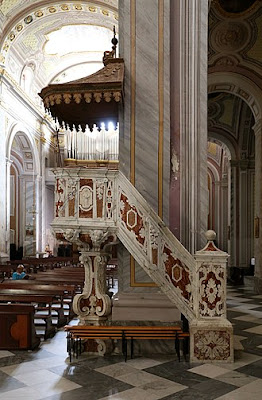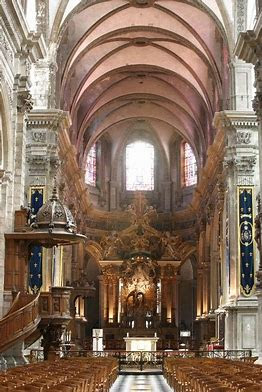Pioneer Bishops of Virginia
This blog will discuss bishops that served in Virginia up to 1900. For more information about Virginia, see my blog February 11, 2017.
Spanish explorers led by Lucas Vasquez de Ayllon established a colony (Guandape) on the James River in what is now Virginia in 1526. Dominican priests were part of the expedition and one of them, Father Antonio de Montesinos, celebrated the first Mass in Virginia in a primitive chapel. This colony was abandoned a year later. In 1570, a group of Jesuits (two priests, three brothers, and three novices) established a mission on the James River. Accompanied by a native guide, Don Luis, who had lived in Spain for 10 years and who had become Catholic, the Jesuits sought to evangelize among the native people. Their guide, however, abandoned them and the Faith and went back to his people. Don Luis eventually took several wives. Told by the Jesuits that this was against Christian teachings, Don Luis and others killed all eight Jesuits in 1571. These Jesuits are now known as the Martyrs of Virginia and are declared Servants of God—the first step toward canonization. The Spanish attempted a colony on the Rappahannock River in 1570 but it lasted only a brief time. The English established their Virginia colony at Jamestown in 1607 and the few Catholics that lived in Virginia during the Colonial period were not allowed to practice their Faith openly.
After the American Revolution, Catholics were allowed to worship freely, however, it was estimated that there were only a few hundred Catholics living in Virginia in 1785. Father Jean Dubois, who later became Bishop of New York, visited Richmond in 1791 and said Mass in the State Capitol—the first Mass celebrated in Richmond. Dubois also visited St. Patrick’s parish (now known as the Basilica of St. Mary of the Immaculate Conception) in Norfolk that same year. St. Mary’s Church in Alexandria was established in 1795 with the help of George Washington. Pope Pius VII created the Diocese of Richmond in 1820 which included all of Virginia (including what is now West Virginia). Catholics at that time were mainly found in Richmond, Norfolk, and the eastern panhandle of what is now West Virginia. Alexandria was still part of the District of Columbia at that time and did not become part of the Diocese of Richmond until 1858. Many of the western counties of Virginia became the Diocese of Wheeling (now West Virginia) in 1850. Pope Pius VI created the Diocese of Arlington in 1974.
Patrick Kelly was born in Ireland in 1779 and ordained a priest in Europe in 1802. He served in parishes in Ireland and as a professor and president of an Irish seminary until he was appointed the first Bishop of Richmond in 1820. He arrived in Norfolk, Virginia, in January 1821, and remained there as Norfolk had more Catholics than Richmond. He engaged in missionary work and supported himself by operating a school. Because the Diocese could not support him and because he had a cool relationship with Archbishop Marechal of Baltimore, Pope Pius VII appointed him in 1822 to be Bishop of Waterford and Lismore in Ireland. He died from lung inflammation in 1829.
From 1822 until 1841, the Diocese of Richmond was administered directly by the Archbishop of Baltimore. In 1822 a report showed about 1,000 Catholics in Virginia, mostly in Norfolk (mostly Irish shipyard workers), Richmond (mostly French), and around Martinsburg and Harpers Ferry. Irish and German laborers settled in Richmond in the 1830s and St. Peter’s Church was established there in 1834.
Richard V. Whelan was born in Baltimore in 1809 and entered Mount St. Mary’s College in Emmitsburg, Maryland, at age 10. He graduated in 1826 and went to Paris to attend seminary. He was ordained a priest for the Diocese of Richmond in 1831. He served as a faculty member and business manager at Mount St. Mary’s and also served as pastor in several western Virginia parishes. Whelan, at the age of 32, was appointed the second Bishop of Richmond in 1841.
Whelan had only six priests to serve his large Diocese. He established a seminary near Richmond, but it soon closed. He recruited Irish priests to work with the Irish railroad workers at Harpers Ferry and in the Shenandoah Valley and he also sought clergy from other European nations. He also established several churches and schools. He moved to Wheeling in 1846 to minister to Irish and Italian railroad workers and to escape from strong anti-Catholic sentiment in Richmond. He requested that his Diocese be divided and in 1850 the Diocese of Wheeling (then Virginia, now West Virginia) was created with Whelan as its first Bishop. Whelan died in 1874.
John McGill was born in Philadelphia in 1809 as the oldest of ten children to parents recently arrived from Ireland. When he was 10, John moved with his parents and siblings to Bardstown, Kentucky. He studied law and practiced in New Orleans for six months before moving back to Kentucky to enter the seminary. McGill was ordained a priest for the Diocese of Bardstown (now the Archdiocese of Louisville) in 1835. He served in parishes in Lexington and Louisville and also edited the Catholic newspaper. McGill was appointed Bishop of Richmond in 1850.
McGill’s Diocese consisted of 7,000 Catholics, 10 churches, and 8 priests. The Diocese was able to avoid the strong anti-immigrant movement that terrorized Catholics elsewhere—Virginia had few immigrants and they tended to be merchants. There was anti-Catholic sentiment, but it was somewhat minimized by the actions of Catholic nuns who nursed victims of yellow fever and cholera epidemics. Bishop McGill served as bishop during the Civil War—when Richmond was the Capital of the Confederate States—and defended Virginia’s secession from the Union. He recruited European priests to serve the Diocese and brought in religious sisters to open schools and a hospital. Bishop McGill died in 1872.
James Gibbons was born in Baltimore in 1834 as the fourth of six children of Irish parents. The family moved back to Ireland in 1839. His mother moved the family to New Orleans in 1853 after the death of her husband. Gibbons entered the seminary in Maryland in 1855 and despite ill health, graduated in 1861 when he was ordained a priest for the Archdiocese of Baltimore. He served as a pastor and as a chaplain at Fort McHenry prior to being named private secretary to Archbishop Martin Spalding in 1865. Gibbons was named the first Vicar Apostolic of North Carolina in 1868 when he was 34 years old. He was named Bishop of Richmond in 1872.
Gibbons was named Bishop of Richmond, Virginia, in 1872. Bishop Gibbons authored Faith of Our Fathers, a popular defense of the American Catholic Faith, in 1876. He also started a ministry to African Americans. He opposed realignment of his Diocese and the Diocese of Wheeling along state lines. He was appointed Archbishop of Baltimore in 1877. Gibbons was named a cardinal in 1886 by Pope Leo XIII—only the second American to be so honored. He died in 1921.
John J. Keane was born in Ireland in 1839. He and his parents and four siblings came to the United States when Keane was seven years old. He was educated in Maryland and ordained a priest for the Archdiocese of Baltimore in 1866. He spent the next 12 years at St. Patrick’s Church in Washington, DC, where he formed a national temperance union, a national group for young men, an organization that aided poor parishes throughout the country, and the Carroll Society. He was appointed Bishop of Richmond in 1878.
Bishop Keane strengthened his clergy through periodic meetings and promoted parish missions for the laity. He supported the right of workers to form unions, and was a leader, along with Cardinal Gibbons and Archbishop John Ireland of St. Paul, in wanting the U.S. Catholic church to reflect American culture, rather than the cultures of the European immigrants. Despite opposition, Keane invited the Josephite Fathers to serve African American Catholics. He frequently spoke to Protestant groups in Virginia thus lessening prejudice against Catholics. Keane was appointed to a committee to establish a national Catholic University in 1885 and in 1886 he was named the first rector of The Catholic University of America, although he remained as Bishop of Richmond until 1888. Keane became known as a good administrator and skillful orator, but his progressive views put him at odds with conservative factions in the United States and Rome. He resigned as rector in 1896 and served in Rome until he was named Archbishop of Dubuque, Iowa, in 1900. He died in 1918.
Augustine Van de Vyver was born in Belgium in 1844 and ordained a priest for the Diocese of Richmond in 1870. He served in Richmond and Harper’s Ferry before becoming vicar general for the Diocese in 1881. He was appointed Bishop of Richmond in 1889. Bishop Van De Vyver founded 12 parishes and built 32 churches, including the Cathedral of the Sacred Heart. He expanded the work of the Josephites and also invited Mother Katherine Drexel to build high schools for African Americans. He built other schools as well. He submitted his resignation in 1903, 1905, and 1908, but withdrew it each time upon the petition of his clergy and the people of the Diocese. Bishop Van De Vyver died in 1911.




































































